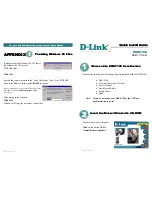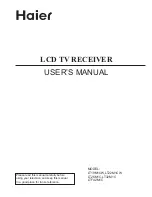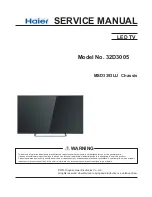
Alignments
EN 77
L04E AB
8.
6.
Adjust the AGC-value with the LEFT/ RIGHT cursor keys
until the voltage at pin 1 of the tuner lies between 3.8 and
2.3 V (default value is “20”).
7.
Switch the set to STANDBY, in order to store the
alignments.
CL (Cathode drive level)
Always set to “5”.
8.3.3
White Tone
In the WHITE TONE sub menu, the values of the black cut off
level can be adjusted. Normally, no alignment is needed, and
you can use the given default values.
The colour temperature mode (NORMAL, COOL and WARM)
and the colour (R, G, and B) can be selected with the UP/
DOWN RIGHT/LEFT cursor keys. The value can be changed
with the LEFT/RIGHT cursor keys. First, select the values for
the NORMAL colour temperature. Then select the values for
the COOL and WARM mode. After alignment, switch the set to
STANDBY, in order to store the alignments.
Default settings:
•
NORMAL:
–
NORMAL R= “26”
–
NORMAL G= “32”
–
NORMAL B= “27”
•
COOL:
–
DELTA COOL R= “-3”
–
DELTA COOL G= “0”
–
DELTA COOL B= “5”
•
WARM:
–
DELTA WARM R= “2”
–
DELTA WARM G= “0”
–
DELTA WARM B= “-6”
8.3.4
Geometry
The geometry alignments menu contains several items to align
the set, in order to obtain correct picture geometry.
Figure 8-4 Geometry alignments
1.
Connect an external video pattern generator to the aerial
input of the TV-set and input a crosshatch test pattern. Set
the generator amplitude to at least 1 mV and set frequency
to 475 MHz.
2.
Set 'Smart Picture' to NATURAL (or MOVIES).
3.
Activate the SAM menu
(see chapter 5 “Service Modes, ...”).
4.
Go to the GEOMETRY sub menu.
5.
Choose HORIZONTAL or VERTICAL alignment.
Now the following alignments can be performed:
Horizontal
•
Horizontal Parallelogram (HP).
Align straight vertical
lines in the top and the bottom; vertical rotation around the
centre.
•
Horizontal Bow (HB).
Align straight horizontal lines in the
top and the bottom; horizontal rotation around the centre.
•
Horizontal Shift (HSH).
Align the horizontal centre of the
picture to the horizontal centre of the CRT.
•
East West Width (EWW).
Align the picture width until the
complete test pattern is visible.
•
East West Parabola (EWP).
Align straight vertical lines at
the sides of the screen.
•
Upper Corner Parabola (UCP).
Align straight vertical lines
in the upper corners of the screen.
•
Lower Corner Parabola (LCP).
Align straight vertical lines
in the lower corners of the screen.
•
East West Trapezium (EWT).
Align straight vertical lines
in the middle of the screen.
•
H60 (Delta HSH for 60Hz, if present).
Align straight
horizontal lines if NTSC system is used (60 Hz) i.s.o. PAL
(50 Hz). Default value is “9”.
Vertical
•
Service blanking (SBL).
Switch the blanking of the lower
half of the screen “on” or “off” (to be used in combination
with the vertical slope alignment).
•
Vertical Shift (VSH).
Align the vertical centring so that the
test pattern is located vertically in the middle. Repeat the
'vertical amplitude' alignment if necessary.
•
Vertical slope (VS).
Align the vertical centre of the picture
to the vertical centre of the CRT. This is the first of the
vertical alignments to perform. For an easy alignment, set
SBL to “on”.
•
Vertical Amplitude (VAM).
Align the vertical amplitude so
that the complete test pattern is visible.
•
Vertical S-Correction (VSC).
Align the vertical linearity,
meaning that vertical intervals of a grid pattern must be
equal over the entire screen height.
•
Vertical Zoom (VX, if present).
The vertical zoom is
added in for the purpose of development. It helps the
designer to set proper values for the movie expand or
movie (16x9) compress. Default value is “25”.
•
V60 (Delta VAM for 60Hz, if present).
Align straight
vertical lines if NTSC system (60 Hz) is used i.s.o. PAL
(50 Hz). Default value is “-2”.
In the next table, you will find the GEOMETRY default values
for the different sets.
E_06532_010.eps
110204
1
2
3
4
5
6
7
8
9
10
11
12
VERT. SLOPE
VERT. SHIFT
VERT. AMPLITUDE
V.S-CORRECTION
HOR. SHIFT
HOR. AMPLITUDE
E/W PARABOLE
UPPER E/W CORNER
LOWER E/W CORNER
E/W TRAPEZIUM
HOR. PARALLELOGRAM
HOR. BOW















































